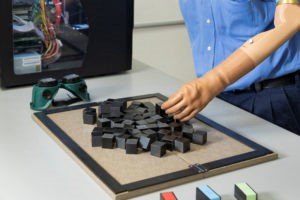Novel system combines intuitive motor control with touch and hand movement sensation
NASSAU, BAHAMAS — Cleveland Clinic researchers have engineered a first-of-its-kind bionic arm for patients with upper-limb amputations that allows wearers to think, behave and function like a person without an amputation, according to new findings published in the research journal Science Robotics.

The Cleveland Clinic-led international research team developed the bionic system that combines three important functions — intuitive motor control, touch and grip kinesthesia and the intuitive feeling of opening and closing the hand.
Collaborators included the University of Alberta and the University of New Brunswick.
Lead investigator Paul Marasco, PhD, associate professor of Cleveland Clinic Lerner Research Institute’s Department of Biomedical Engineering, said: “We modified a standard-of-care prosthetic with this complex bionic system which enables wearers to move their prosthetic arm more intuitively and feel sensations of touch and movement at the same time.
“These findings are an important step towards providing people with amputation with complete restoration of natural arm function.”

The system is the first to test all three sensory and motor functions in a neural-machine interface all at once in a prosthetic arm.
The neural-machine interface connects with the wearer’s limb nerves. It enables patients to send nerve impulses from their brains to the prosthetic when they want to use or move it and to receive physical information from the environment and relay it back to their brain through their nerves.
The artificial arm’s bi-directional feedback and control enabled study participants to perform tasks with a similar degree of accuracy as non-disabled people.

“With the new bionic limb, people behaved like they had a natural hand,” Marasco added.
The researchers tested their new bionic limb on two study participants with upper-limb amputations who had previously undergone targeted sensory and motor reinnervation — procedures that establish a neural-machine interface by redirecting amputated nerves to remaining skin and muscles.
While wearing the advanced prosthetic, participants performed tasks reflective of basic, everyday behaviors that require hand and arm functionality.

With their newly developed advanced evaluation tools, the researchers assessed how performance with the bionic limb compared to that of non-disabled people and people with amputations who have traditional prosthetic devices.
According to Marasco, because people with traditional prosthetics cannot feel with their limbs, they behave differently than people without an amputation while completing tasks during daily living. For example, traditional prosthesis wearers must constantly watch their prosthetic while using it and have trouble learning to correct for mistakes when they apply too much or little force with their hand.

With the new artificial arm and the advanced evaluation tools, the researchers could see that the study participants’ brain and behavioral strategies changed to match those of a person without an amputation. They no longer needed to watch their prosthesis; they could find things without looking, and they could more effectively correct their mistakes.
“Over the last decade or two, advancements in prosthetics have helped wearers to achieve better functionality and manage daily living on their own,” said Marasco.
“For the first time, people with upper-limb amputations are now able to again ‘think’ like an able-bodied person, which stands to offer prosthesis wearers new levels of seamless reintegration back into daily life.”






